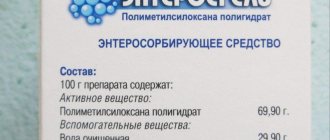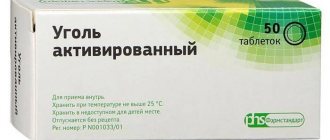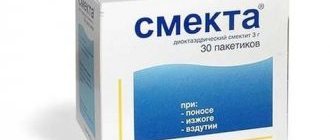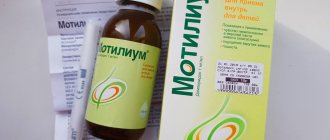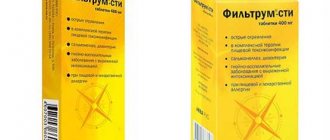Cerucal is one of the representatives of the group of antiemetics, which acts as a dopamine receptor blocker. It is used not only to treat adults, but also for children of different ages. Its ability is to quickly stop the urge to vomit. Take Cerucal for children according to the instructions for use.
Release form and dosage composition
The drug Cerucal is available in the form of tablets and solution for injection. The solution is transparent, sterile, colorless and odorless, available in 2 ml transparent glass ampoules. The ampoules are placed in plastic trays of 5 pieces (2) in a cardboard box; detailed instructions describing the characteristics of the solution are attached to the drug.
1 ml of solution contains 5 mg of the active substance - Metoclopramide hydrochloride, 1 ampoule contains 10 mg of the active substance. The auxiliary components are water for injection and sodium chloride.
Impact of the product
The main active ingredient is metoclopramide hydrochloride. Its function is to block the work of receptors through which impulses from problem areas of the mucous surface of the stomach and duodenum are transmitted to the vomiting center in the brain. This is the formation of the gag reflex.
Another focus of Cerucal, according to gastroenterologists, should be considered an increase in the tone associated with the smooth muscles of the stomach. This allows food to quickly penetrate from there into the intestinal area. In addition, the benefit of the drug is to protect the esophagus from the reflux of gastric contents and the excretion of bile. Another positive property is ensuring timely bowel movements, which helps to cope with constipation, belching and heartburn.
Indications for use
The drug Cerucal in the form of a solution for injections is intended for intravenous and intramuscular administration. The main indications for prescribing the drug are:
- nausea and vomiting of various origins - associated with eating poor-quality and stale food, diseases of the stomach and pancreas;
- nausea and vomiting caused by taking certain medications;
- biliary dyskinesia;
- reflux esophagitis;
- postoperative gastric hypotension, resulting in a feeling of heaviness, nausea and discomfort;
- gastric paresis due to severe diabetes mellitus;
- the first few days after gastroduodenal intubation or endoscopic examinations.
Contraindications
Before starting to use the drug, you should carefully read the attached instructions. Cerucal injections are contraindicated for patients in the following cases:
- individual intolerance to the components of the drug;
- pyloric stenosis;
- pheochromocytoma;
- intestinal obstruction or suspicion of it;
- prolactin-dependent tumor;
- extrapyramidal disorders;
- epilepsy;
- age up to 2 years (for this dosage form);
- pregnancy 1st trimester.
Cerucal injection solution has a number of relative contraindications (when the drug can be prescribed only in extreme cases, in the presence of serious indications):
- pregnancy 2nd and 3rd trimesters;
- arterial hypertension;
- bronchial asthma;
- kidney and liver diseases;
- Parkinson's disease;
- thrombophlebitis;
- bronchial asthma or a history of severe bronchospasm;
- The patient's age is over 65 years.
Storage conditions
Keep ampoules with solution or a jar of tablets at home in a place hidden from direct sunlight at temperatures up to 30 degrees. The drug should be stored so that small children cannot reach it.
The shelf life of both the injectable form of Cerucal and tablets is 5 years. If it has expired (it is important to check the date on the box), the use of the drug is unacceptable. The solution from an opened ampoule should be used within 15-30 minutes. It cannot be stored until the next injection.
In a dark place, out of reach of children, at a temperature not exceeding 25 degrees Celsius.
Directions for use and dosage
Cerucal solution is intended for intravenous or intramuscular administration. According to the instructions, patients over 14 years of age and adults are prescribed 2 ml of solution 3 times a day. For children from 2 years to 14 years, the dose of the drug is calculated individually, depending on body weight and characteristics of the body.
The drug can be used to prevent nausea and vomiting during treatment with cytostatics in cancer patients. In this case, the solution is used for short-term and long-term drip infusions. For intravenous infusions of Cerucal solution, isotonic sodium chloride solution or 5% glucose solution is used.
When administering the solution intramuscularly, there is no need to further dilute the contents of the ampoule with anything.
The duration of the course of treatment with the drug is set individually for each individual patient, depending on the indication and characteristics of the body.
Can children be given Cerucal when vomiting?
The use of this prokinetic agent is permitted for gastrointestinal diseases accompanied by frequent and profuse vomiting. Self-administration is excluded in any situation, so you should definitely visit a doctor for advice on use.
Indications for use:
- Nausea and vomiting.
- Gastric pyloric stenosis.
- Duodenal stenosis.
- Frequent and prolonged hiccups.
- Gastric paresis.
- Decreased tone of the gastrointestinal tract.
- Severe flatulence.
- Dyskinesia of the bile ducts.
For children, this drug is used from the age of two years. Due to the fact that younger patients may experience side effects after taking it, self-prescription of the drug for treatment is unacceptable. However, there is no special form of Cerucal for children.
The product is universal, and the dosage is calculated based on the patient’s weight.
Use during pregnancy and breastfeeding
Cerucal injections are not prescribed to women in the 1st trimester of pregnancy, since there is no information about how the drug affects the intrauterine development of the fetus and there is no experience in using this drug in obstetrics.
The use of Cerucal injection solution for women in the 2nd and 3rd trimesters of pregnancy is possible according to indications, but only in situations where the expected benefit to the mother outweighs the possible risks to the fetus. Treatment is carried out under the supervision of a doctor.
Prescribing Cerucal injections to women who are breastfeeding requires consultation with a doctor. The drug is excreted in breast milk, so it is preferable to interrupt lactation during therapy.
Side effects
During treatment with Cerucal, the patient may experience adverse reactions:
- from the nervous system - dizziness, insomnia, weakness, lethargy, apathy, an unreasonable feeling of fear, anxiety, tinnitus, twitching of the facial muscles, spasms of the facial muscles, tremor of the limbs;
- from the cardiovascular system - changes in blood pressure (decrease or increase), tachycardia;
- from the digestive system - dry mouth, heartburn, belching, feeling of heaviness in the stomach, constipation, bloating, increased gas formation;
- from the endocrine system - galactorrhea in women (discharge of colostrum from the breast, not associated with lactation), gynecomastia in men, menstrual irregularities, impaired potency in men;
- local reactions - puncture of a vein, subcutaneous hematoma, air thromboembolism, formation of a painful infiltrate, orppnnpppppaasvsaapeaava
If one or more of the described side effects develops, discontinue treatment with the drug and consult a doctor.
Operating principle
Metoclopramide, the active substance of Cerucal, blocks serotonin and dopamine receptors located in the stomach and duodenum, and chemoreceptors located in the medulla oblongata. Because of this, the urge to vomit stops and the patient’s condition returns to normal.
Thanks to the effect of the drug on the autonomic nervous system, the following results are achieved:
- the tone of the muscles of the digestive organs, including peristalsis, improves;
- motor activity of the esophagus and manifestations of sphincter spasm between the bile duct and duodenum are reduced;
- hiccups decrease.
Cerucal does not affect the production of digestive juice, bile and pancreatic enzymes.
The drug is completely absorbed into the blood, and the maximum concentration is observed after an hour after administration. The action lasts about half a day.
Metoclopramide is broken down in the liver and is eliminated by half within 3–5 hours in healthy people and after 14 hours in patients with liver failure.
It is removed from the body along with waste products on the first day. The substance easily penetrates the blood-brain barrier.
With intravenous injections, the effect appears after 1–3 minutes, and with intramuscular injections - after 15.
Overdose
If the dosage of the drug specified in the instructions is exceeded, the patient develops overdose symptoms, which are clinically expressed as follows:
- confusion;
- anxiety, drowsiness, convulsions;
- disorientation in space;
- extrapyramidal disorders;
- an increase or rapid decrease in blood pressure;
- bradycardia.
If such clinical symptoms appear, treatment with the drug is immediately stopped. In most cases, all negative reactions and signs of overdose disappear on their own 1-2 days after discontinuation of therapy. In case of severe poisoning of the body with Cerucal, the patient may experience impaired liver and kidney function.
Treatment of overdose is symptomatic. The patient should be under medical supervision until the condition stabilizes.
Interaction of the drug with other drugs
Cerucal solution is incompatible with solutions for intravenous infusion that have an alkaline environment.
When prescribed simultaneously with antibiotics, Paracetamol, Levodopa, Cerucal solution enhances the absorption of these drugs, which increases the risk of side effects and toxic liver damage.
The drug Cerucal in the form of injections reduces the absorption of Digoxin and Cimetidine when the drugs are prescribed simultaneously.
Under the influence of Cerucal solution, the inhibitory effect of ethanol on the central nervous system, as well as drugs that inhibit the speed of psychomotor reactions, increases.
The drug Cerucal reduces the therapeutic effect of drugs from the group of H2-histamine blockers, which should be taken into account when prescribing these drugs simultaneously.
When Cerucal injections are prescribed simultaneously with hepatotoxic drugs, the risk of toxic liver damage increases.
Reviews
Valeria:
When my child and I were in the hospital with poisoning, in addition to other medications, we were injected with Cerucal for the first two days. Fortunately, there were no side effects, although, as we were told, this drug is not suitable for everyone. By the way, he eliminated the vomiting very quickly, but I would not have dared to give such a remedy on my own. The child was a little over three years old, I no longer remember the dosage of the drug.
Maria:
We used Cerucal as prescribed by a doctor, the child had severe vomiting, to the point of dehydration. At first we were treated in a hospital, but then we had to return home (the infectious diseases department was full, and our registration was not local). As a result, they completed their treatment at home and drank Cerucal according to a previously prescribed regimen.
special instructions
During treatment with Cerucal, patients should refrain from driving a car or operating complex equipment that requires increased concentration. This is due to possible dizziness and lethargy of the patient during therapy.
During treatment with the drug, the patient should refrain from drinking alcohol, since combining Cerucal with alcohol increases the risk of developing side effects from the liver and central nervous system.
Adolescents are more at risk of developing side effects than adult patients, so they should be under constant supervision of specialists during treatment with Cerucal.
For patients suffering from severe kidney and liver diseases, which are accompanied by dysfunction of the organ, the dose of the drug is calculated individually, depending on the body weight and characteristics of the patient’s body.
The drug Cerucal in this dosage form cannot be prescribed to children under 2 years of age, since there is no experience with use and safety has not been established.
Price
Cerucal is a drug presented in pharmacies in several forms, each of which has its own cost. The products are not divided into different tablets and ampoules, which are intended for use in children or for adult patients. You just need to carefully calculate the permissible dosage.
Average cost of drugs:
- 50 tablets – 110 rubles;
- 10 ampoules – 220 rub.
Cerucal is included in the list of vital, essential medications, so differences in prices in different pharmacies will be minimal. At the same time, it is always possible to replace it with another available analogue in the same dosage.
The need to quickly initiate treatment for children is particularly important. This feature is directly related to the principles of functioning of the child’s body.



